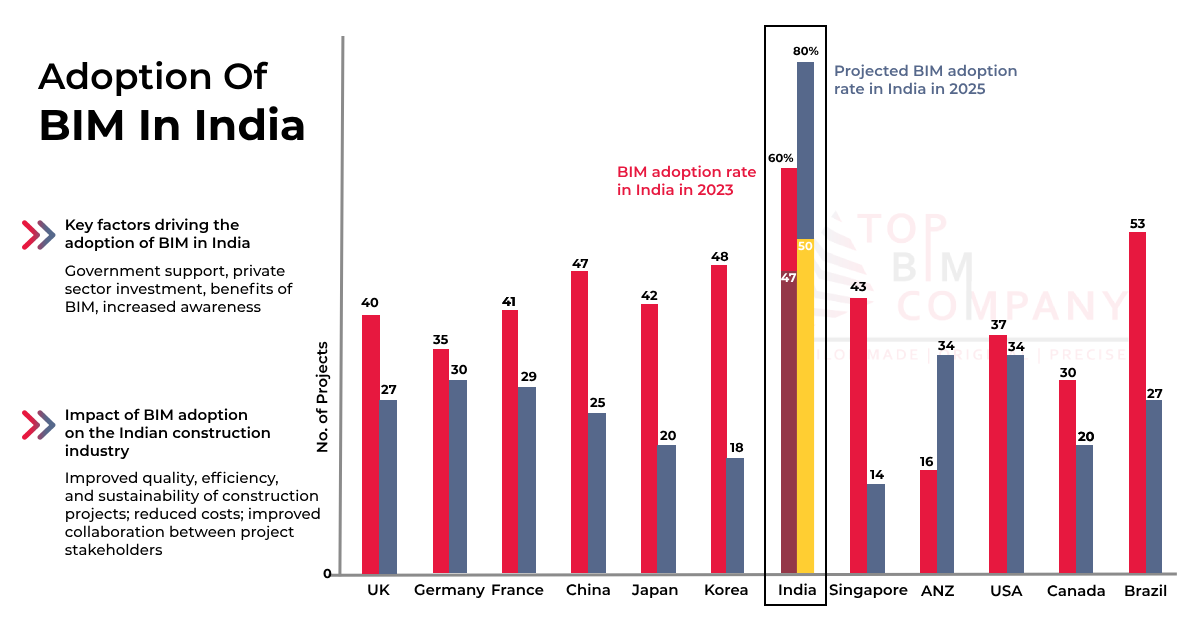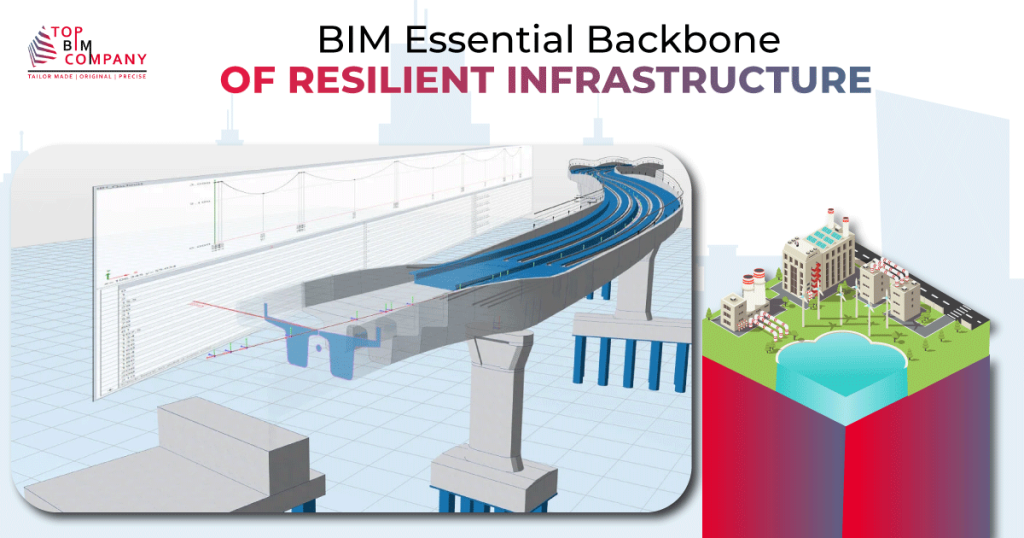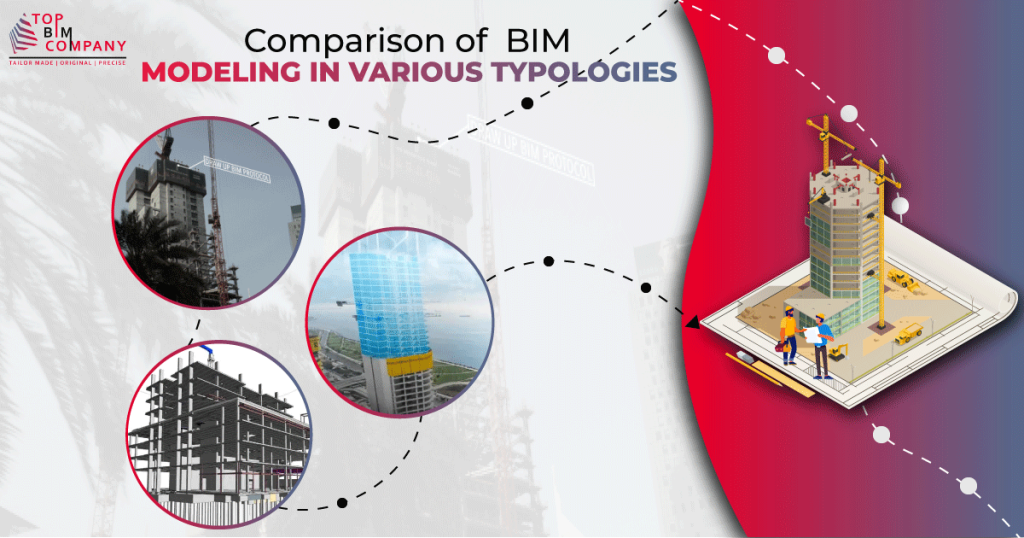
Building Information Modeling (BIM) is a digital representation of a physical asset, such as a building or infrastructure project. It is a process that creates and manages information throughout the project lifecycle, from design to construction, operation, and maintenance.
Table of Contents
ToggleBuilding Information Modeling Software Market is expected to grow at a CAGR of 22.4% from 2022 to 2027. BIM is growing rapidly in the Indian construction industry, as it offers a number of significant benefits, including improved collaboration and communication, cost savings and time efficiency, and quality control and sustainability.
You would like to explore –
Overview of BIM
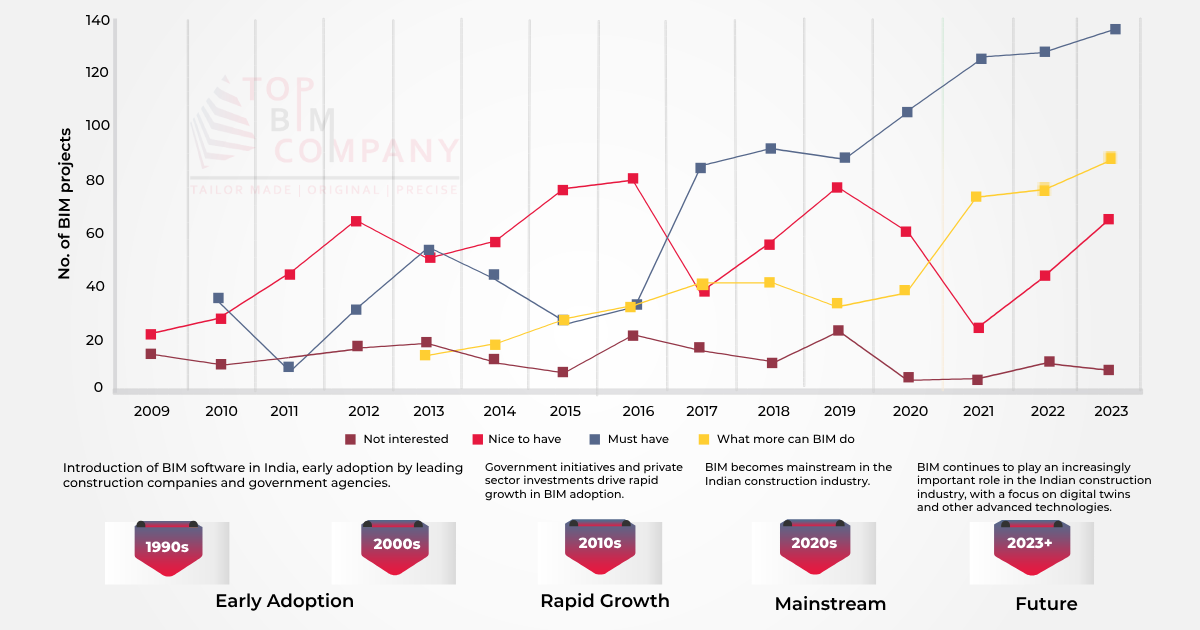
BIM is a digital process that uses 3D models to create and manage information about a physical asset. BIM models contain not only geometric information, but also non-geometric information such as materials, properties, and costs. This information can be used to generate drawings, reports, and schedules, and to simulate the construction and operation of the asset.
Also Read: Introduction to Building Information Modeling (BIM) – Complete Guide
Significance of BIM in the Construction Sector:
BIM is transforming the construction industry by providing a platform for collaboration and information sharing amongst all stakeholders involved in a project. This can lead to a number of benefits, including:
- Reduced errors and omissions
- Improved communication and coordination
- Increased productivity and efficiency
- Cost savings
- Improved quality control
- Enhanced sustainability
The State of the Indian Construction Industry
India’s rapid urbanization and economic growth project the construction of 700-900 million square meters annually. To meet this challenge, Indian architectural firms must embrace modern, efficient design methods.
Research, like Arayici et al. (2011b), shows that BIM adoption boosts efficiency, reduces waste, and adds value, making it crucial for architects in India.
Current Challenges and Trends
The Indian construction industry is one of the largest in the world, and is expected to continue to grow in the coming years. However, the industry faces a number of challenges, including:
- Fragmented supply chain
- Shortage of skilled labor
- Low productivity
- Delays and cost overruns
- Lack of technological adoption
By 2025, it is generally accepted that BIM might enable savings in the global infrastructure sector of 15–25% (www.eubim.eu). But time and cost reductions aren’t the only advantages of BIM. It might present the building sector with some significant chances to address the upcoming climate change concerns, such as waste, energy consumption, and built environment resilience.
The Need for Technological Advancements:
The Indian construction industry needs to embrace technological advancements in order to overcome the challenges it faces and meet the growing demand for infrastructure and housing. BIM is one such technology that can help the industry to improve its efficiency and productivity.
Adoption of BIM in India
Factors Driving BIM Implementation
A number of factors are driving the adoption of BIM in India, including:
- Government initiatives and policies
- Growing demand from the private sector
- Increasing awareness of the benefits of BIM
- Early Adopters and Success Stories
Which Industry Stakeholders are mostly adopting BIM in India?
The availability of skills and technical experience, the cost of implementation and training, and associated characteristics of the technology or design teams on the project are some of the factors that have a significant impact on BIM implementation.
According to a 2016 assessment by the India BIM Association (IBIMA), India’s level of BIM maturity is classified as design. BIM is generally used by Indian firms for drawing and design work. 37% of survey participants said they had excellent knowledge about BIM.
Regarding BIM training provided to the organization, 40.96% of respondents said they receive “BIM training internally, while 34.5% said they learn on their own via learning platforms.
Government Initiatives and Policies
The Indian government is playing a key role in promoting the adoption of BIM in the construction industry. A number of initiatives and policies have been implemented, including:
- The National BIM Implementation Framework
- The Smart Cities Mission
- The National Infrastructure Pipeline
Is the government of India really promoting BIM?
The Indian government is promoting the use of BIM in the construction industry, but it has not yet made BIM mandatory. The government is encouraging the use of BIM through various initiatives, such as issuing circulars, developing standards and guidelines, and investing in training. It is likely that the government will make BIM mandatory in the future, following the lead of the UK government.
The UK’s BIM Level 2 protocol is a government-led initiative for construction and infrastructure projects. It mandates:
Use of BIM on government-funded projects.
- National BIM standards (PAS 1192-2, PAS 1192-3)
- Collaborative working and a Common Data Environment
- Structured information exchanges
- Project stages with defined deliverables
- Common file formats (COBie, IFC)
- Classification systems (Uniclass, COBie)
- Training and education programs
- BIM Execution Plan (BEP) for project specifics
- Utilization of BIM data beyond construction
This protocol aims to enhance project efficiency, transparency, and data-driven decision-making.
The Indian government is promoting BIM, but it has not yet made it mandatory for all public projects like the UK has. However, the government has set a target of achieving 100% BIM adoption in all public projects by 2025.
The government is taking a number of steps to promote BIM, including:
- Issuing guidelines and standards for BIM implementation
- Providing financial assistance for BIM training and certification programs
- Establishing BIM Centers of Excellence (CoEs) across the country
- Mandating the use of BIM for selected public projects
In 2019, the Ministry of Housing and Urban Affairs (MoHUA) issued a notification mandating the use of Level 2 collaborative BIM for all central government housing projects costing more than INR 100 crore.
In 2021, the National Highways Authority of India (NHAI) issued a circular mandating the use of Level 2 collaborative BIM for all highway projects costing more than INR 100 crore.
The government is also working on developing a National BIM Protocol, which will provide a common framework for BIM implementation in India. The draft protocol is expected to be released for public consultation in the near future.
While the Indian government is promoting BIM, it is still too early to say whether it will make it mandatory for all public projects like the UK has. However, the government’s efforts to promote BIM are likely to lead to its widespread adoption in the Indian construction industry in the coming years.
In addition to the government’s efforts, there is a growing awareness of the benefits of BIM among Indian construction industry stakeholders. The Indian government is providing data and incentives to promote BIM adoption in the country.
Data:
The government is making available a variety of data that can be used for BIM, including:
- Geographic Information System (GIS) data
- Building codes and regulations
- Standard operating procedures (SOPs)
- Material and product specifications
- Project data from completed BIM projects
This data is available through a variety of channels, including government websites, open data portals, and BIM repositories.
Incentives:
The government is also providing financial and non-financial incentives to promote BIM adoption.
Financial incentives include:
- Subsidies for BIM training and certification programs
- Tax breaks for companies that adopt BIM
- Grants for research and development projects on BIM
Non-financial incentives include:
- Priority consideration for BIM-adopting companies in government tenders
- Awards and recognition for BIM-enabled projects
- Support for the establishment of BIM Centers of Excellence (CoEs)
The government’s data and incentivization programs are helping to make BIM more accessible and affordable for Indian construction industry stakeholders. This is likely to lead to the widespread adoption of BIM in India in the coming years.
Here are some specific examples of the government’s data and incentivization programs:
- The Ministry of Housing and Urban Affairs (MoHUA) has established a National BIM Repository, which provides access to a variety of BIM resources, including data, models, and best practices.
- The National Highways Authority of India (NHAI) has developed a BIM Toolkit, which provides guidance on BIM implementation for highway projects.
- The Bureau of Indian Standards (BIS) has published a number of BIM standards, including IS/ISO 19650, which provides a framework for BIM implementation.
The government is also providing financial assistance to companies that adopt BIM. For example, the Ministry of Micro, Small and Medium Enterprises (MSME) provides subsidies to MSMEs for BIM training and certification programs.
The government’s data and incentivization programs are playing a key role in promoting BIM adoption in India. These programs are helping to make BIM more accessible and affordable for Indian construction industry stakeholders, which is likely to lead to its widespread adoption in the coming years.
BIM in Infrastructure Projects:
- Improved Collaboration and Communication:
BIM provides a platform for collaboration and information sharing between all stakeholders involved in a project. This can lead to improved communication and coordination, and reduced errors and omissions.
- Cost Savings and Time Efficiency:
BIM can help to save costs and improve time efficiency by reducing errors and rework, streamlining workflows, and improving coordination between stakeholders.
- Quality Control and Sustainability:
BIM can help to improve quality control by providing a platform for clash detection and simulation. It can also help to enhance sustainability by providing information about the energy performance and environmental impact of a building or infrastructure project.
Challenges and Barriers in Adopting BIM in Indian Construction and Infrastructure Ecosystem:
- Cost and Resource Constraints:
The cost of BIM software and implementation can be a barrier for some companies. In addition, there is a shortage of skilled BIM professionals in India.
- Awareness and Skill Gaps:
There is a lack of awareness about the benefits of BIM among some stakeholders in the Indian construction industry. In addition, there is a shortage of skilled BIM professionals.
- Interoperability Issues:
The lack of interoperability between different BIM software packages can also be a challenge.
Role of Government in Promoting BIM
The Indian government is playing a key role in promoting BIM adoption in the construction industry. In 2015, the government launched the National BIM Standards and Guidelines, which provide a framework for the implementation of BIM in India. The government has also mandated the use of BIM on all public sector construction projects costing more than Rs. 100 crores
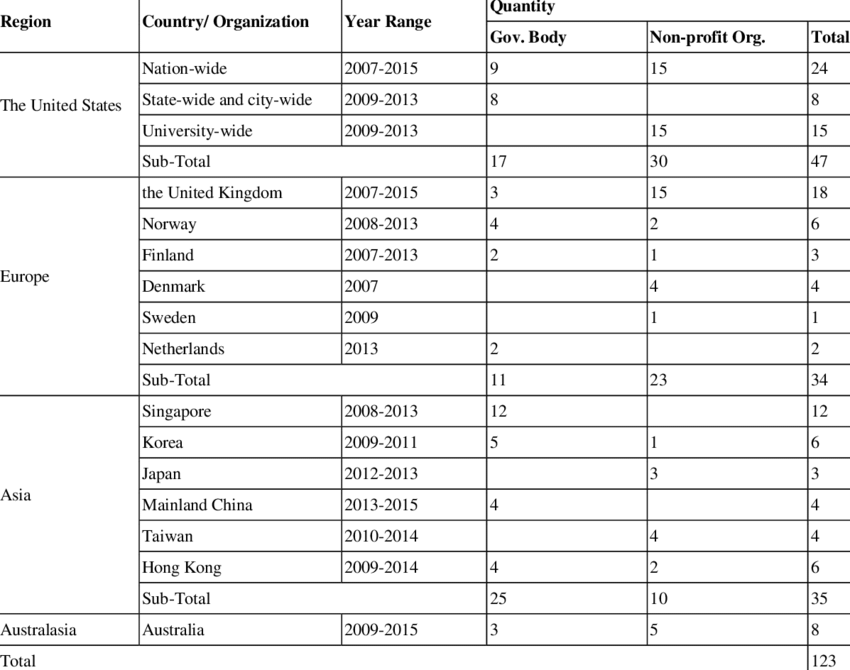
Key Policies and Regulations:
The following are some of the key policies and regulations that are promoting BIM adoption in India:
- National BIM Standards and Guidelines (2015)
- Smart Cities Mission (2015)
- Pradhan Mantri Awas Yojana (PMAY) (2015)
- Digital India (2015)
- National Highway Development Programme (NHDP)
BIM Education and Training
Role of Academia and Training Centers:
Academia and training centers are playing a vital role in BIM education and training in India. Many universities and colleges are now offering BIM courses as part of their civil engineering and architecture programs. There are also a number of private training centers that offer BIM courses.
Upskilling the Workforce:
The construction industry in India needs to upskill its workforce in BIM in order to meet the growing demand for BIM-skilled professionals. The government, academia, and training centers are working together to upskill the workforce in BIM.
Notable BIM Projects in India:
Mega Projects that wouldn’t have constructed without BIM:
- Chhatrapati Shivaji International Airport Terminal 2 used BIM clash detection
- Nagpur Metro or Maha Metro used 5D BIM
- Chenab Bridge in Kashmir, the tallest & longest spanning railway bridges in the world used BIM
- Delhi Metro Rail Project used BIM for 33% reduced construction cost, 43% enhanced labor productivity and 50% decreased greenhouse gas emission
- JIO World Centre used BIM integrated with BIM
Future Prospects and Emerging Trends
- The Evolution of BIM in India:
BIM has evolved rapidly in India in recent years. The initial focus was on 3D modeling and collaboration. However, the focus is now shifting to 5D and 6D BIM, which includes cost and time estimation, and facility management.
- Integrating BIM with Emerging Technologies:
BIM is being integrated with emerging technologies such as AI, ML, and IoT to create more powerful and intelligent BIM solutions. For example, AI is being used to automate BIM tasks, such as clash detection and quantity takeoff. ML is being used to develop predictive maintenance models for BIM-enabled facilities. IoT is being used to collect data from real-time sensors and integrate it with BIM models to create digital twins of buildings and infrastructure.
Also Read: Future Of Construction Is Building Information Modeling (BIM)
Prominence of BIM in architectural education through edtech startups
Building Information Modeling (BIM) is a rapidly evolving technology that is transforming the architecture, engineering, and construction (AEC) industry. BIM is a digital representation of a physical asset, such as a building or infrastructure project that can be used to simulate, visualize, and analyze the asset throughout its lifecycle.
BIM is becoming increasingly important in architectural education, as it is an essential skill for architects to have in order to compete in the global job market. Edtech startups are playing a vital role in making BIM education more accessible and affordable.
Some of the ways in which edtech startups are promoting BIM in architectural education include:
- Offering online and offline BIM courses and training programs: Edtech startups are offering a variety of BIM courses and training programs that are tailored to the needs of architects at different levels of experience. These courses can be taken online or in person, making them convenient for students and professionals alike.
- Developing BIM-based learning resources: Edtech startups are developing a variety of BIM-based learning resources, such as interactive tutorials, simulations, and games. These resources can help students to learn BIM concepts in a more engaging and effective way.
- Providing access to BIM software and hardware: Edtech startups provide students and professionals with access to BIM software and hardware at a discounted rate. This makes it more affordable for students and professionals to learn and use BIM.
Examples of edtech startups that are promoting BIM in architectural education:
- Novatr: Novatr is an edtech startup that offers a cloud-based BIM platform for architectural education. It provides students with access to BIM software and training materials, helping them develop the skills they need to use BIM in their professional careers.
- Built By You: Built By You is an online platform that offers BIM courses and training programs to students and professionals. The platform also provides access to BIM software and hardware at a discounted rate.
- BIMxperts: BIMxperts is an online platform that offers BIM courses and training programs to students and professionals. The platform also provides access to a community of BIM experts who can provide support and guidance.
- AEC EdTech: AEC EdTech is an online platform that offers a variety of BIM-based learning resources, such as interactive tutorials, simulations, and games. The platform also provides access to BIM software and hardware at a discounted rate.
Integrating BIM with Emerging Technologies as PPP is increasing
Public-private partnerships (PPPs) are becoming increasingly common in the AEC industry. The arrangements between the public sector and the private sector are pushing the boundaries of how BIM is being done on government projects. The public sector is providing financial support for research and development, while the private sector is providing technical expertise on new-age BIM technologies.
Emerging technologies, such as artificial intelligence (AI), machine learning (ML), and the Internet of Things (IoT), are playing a big-time role in more precise BIM solutions.
Here are some examples of how BIM is being integrated with emerging technologies:
- AI-powered BIM clash detection:
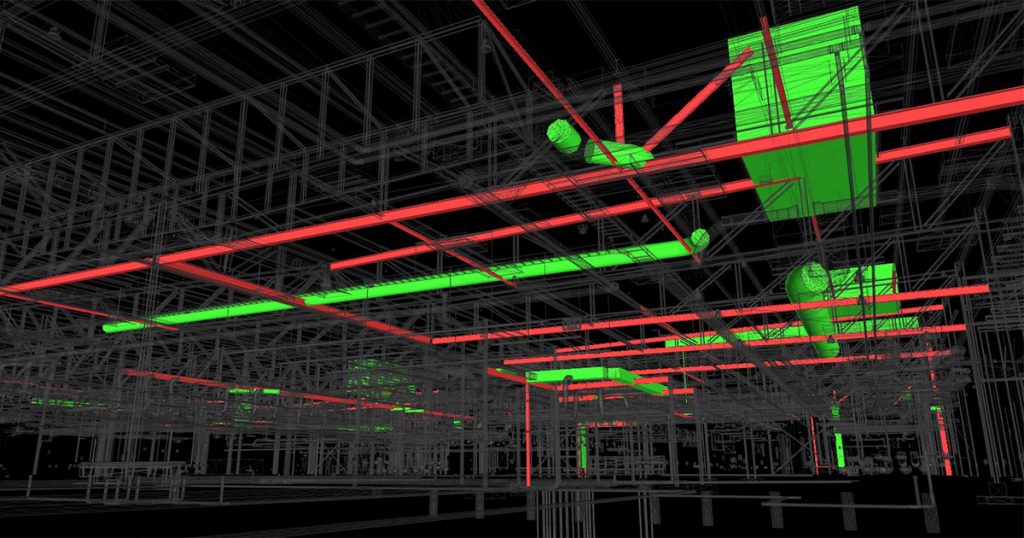
AI is being used to develop BIM software that can automatically detect clashes and conflicts between different components of a building or infrastructure project. This can help to reduce the risk of errors and delays during construction.
- ML-based BIM predictive maintenance:

Image Source:mdpi
ML is being used to develop BIM software that can predict when components of a building or infrastructure project are likely to fail. This can help to improve the efficiency and effectiveness of maintenance operations.
IoT-enabled BIM digital twins:
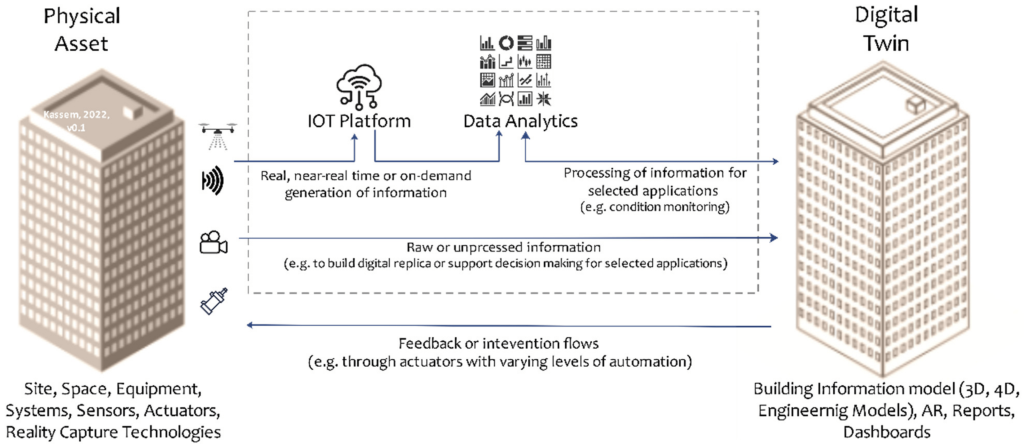
Image Source:mdpi
IoT is being used to collect data from real-time sensors and integrate it with BIM models to create digital twins of buildings and infrastructure. Digital twins can be used to monitor the condition of assets and predict future performance.
Final Thought
As the Indian economy is moving towards increasing investment in its infrastructure, the probability of BIM being used more often will solidify. Right now, PPPs are playing a key role in this transformation by providing a platform for public and private sector collaboration to develop and implement BIM-enabled projects. BIM-enabled projects are told to employ a set of more intelligent workforce on infrastructure projects, guaranteeing better ROI. Therefore, the future of development in India is surely BIM, it is just a matter of time and how quickly the government adopts it.
Check out our video on how BIM would pave India’s exponential infrastructure growth in the coming times.
Further Reading
Future Of Construction Is Building Information Modeling (BIM)
BIM LOD (Level Of Development)– 100 200 300 350 400 500
Applications Of BIM Technology In The Construction Industry
Building Information Modeling In Construction Management
You would like to explore our services
BIM Services | Architectural BIM Services | Structural BIM Services | MEP BIM Services
Our Services
Latest Post
Get A Free Quote
BIM Construction is the Future
Building information modeling (BIM) is the future of building design and construction. Get in touch with our BIM Experts.

